 Weird Stuff
Weird Stuff  Weird Stuff
Weird Stuff  Our World
Our World 10 Ways Your Christmas Tree Is More Lit Than You Think
 Movies and TV
Movies and TV The 10 Coolest Stars to Set Sail on The Love Boat
 History
History 10 Things You Didn’t Know About the American National Anthem
 Technology
Technology Top 10 Everyday Tech Buzzwords That Hide a Darker Past
 Humans
Humans 10 Everyday Human Behaviors That Are Actually Survival Instincts
 Animals
Animals 10 Animals That Humiliated and Harmed Historical Leaders
 History
History 10 Most Influential Protests in Modern History
 Creepy
Creepy 10 More Representations of Death from Myth, Legend, and Folktale
 Technology
Technology 10 Scientific Breakthroughs of 2025 That’ll Change Everything
 Weird Stuff
Weird Stuff Ten Bizarre Facts About The Doge Meme
 Our World
Our World 10 Ways Your Christmas Tree Is More Lit Than You Think
 Movies and TV
Movies and TV The 10 Coolest Stars to Set Sail on The Love Boat
Who's Behind Listverse?

Jamie Frater
Head Editor
Jamie founded Listverse due to an insatiable desire to share fascinating, obscure, and bizarre facts. He has been a guest speaker on numerous national radio and television stations and is a five time published author.
More About Us History
History 10 Things You Didn’t Know About the American National Anthem
 Technology
Technology Top 10 Everyday Tech Buzzwords That Hide a Darker Past
 Humans
Humans 10 Everyday Human Behaviors That Are Actually Survival Instincts
 Animals
Animals 10 Animals That Humiliated and Harmed Historical Leaders
 History
History 10 Most Influential Protests in Modern History
 Creepy
Creepy 10 More Representations of Death from Myth, Legend, and Folktale
 Technology
Technology 10 Scientific Breakthroughs of 2025 That’ll Change Everything
Top 10 Life-Forms That Belong In A Horror Movie
We exist in a living, dynamic world flourishing with diversity and beauty, from the tiniest of kittens to the noble and towering sequoia. Everywhere you look, our planet is chock-full of astounding animals and exotic plants that amaze and delight us every day!
But now, let’s cast off the rose-tinted glasses and take a closer look at some of this diversity, especially the creatures that go bump (and screech and hiss) in the night. Let us examine the undersides of logs, the abysmal depths of the sea, and beneath the canopies of the most remote rain forests. Herein lie such freaks of nature and abominations of biology that one might think were straight from Planet X, or at least some secret lab here on Earth.
Either way, this motley collection of creepazoids is chilling enough to give us nightmares, and the fact that they’re real and not borrowed from the world of science fiction is plenty scary in itself. So, let us sit back and review this compilation of monstrosities that could have sent Marvin the Martian packing, but remember: No feeding the plants—they bite!
10 Globsters
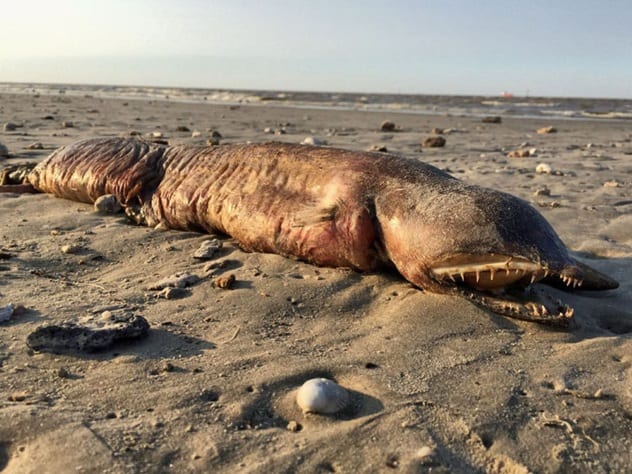
Picture this disturbing scenario: You are enjoying a pleasant walk along the beach, enjoying an idyllic, sunny, frolicsome day at the ocean. Suddenly, there it is right in front of you—some monstrously humongous and unrecognizable glob of putrid flesh (commonly known as a “globster”) washed up from the depths. This actually happens frequently around the world, with some such discoveries requiring DNA testing for proper identification. We’re talking dead whales, porpoises, squid, even land mammals, all in some advanced state of decomposition to the point that they’re unrecognizable and appear to be from out of this world! Others are grotesque and alien-looking simply because they were plucked up from the great black abyss, somehow having been sucked up and cast out into a harsh, terrestrial world of sunlight and warmth.[1]
As a matter of fact, we’ve seen many examples of such deep-sea discards in the news. In July 2008, a ghastly, “beaked” animal carcass washed ashore at Montauk, Long Island. Rumors suggested the corpse might be an alien, a raccoon, a dog, or perhaps a secret scientific experiment gone awry. But we may possibly never know because the body mysteriously disappeared a short time later. And in September 2017, on the Philippine island of Leyte, a huge, 9.8-meter (32 ft), decaying corpse was found lingering in the surf, stinking up the entire beach, and while it was never officially identified, many people assume it to have been a whale. Also in September 2017, an elongated, fanged creature graced the shoreline of Texas City, Texas, in the aftermath of Hurricane Harvey. It was identified to be just a fangtooth snake-eel (Aplatophis chauliodus), not a monster after all.
As odd as these putrefying blobs of flesh seem to us today, we can only imagine how they were perceived centuries back, before modern forensics. In 1808, a huge carcass, which initial responders measured to be 16.8 meters (55 ft) in length, washed up on the Scottish island of Stronsay, and it emanated a stench that filled the air. The Stronsay Beast, as it became known, had a long, serpentine body from which sprouted three pairs of legs (or so was thought at the time), and it was the first of many such bodies to grace the island in such a graceless fashion. These malodorous corpses helped form the sea monster mythology of Scotland, the queen of which, that graceful behemoth Nessie, rules to this day.
9 Slime Molds Make Good Pets
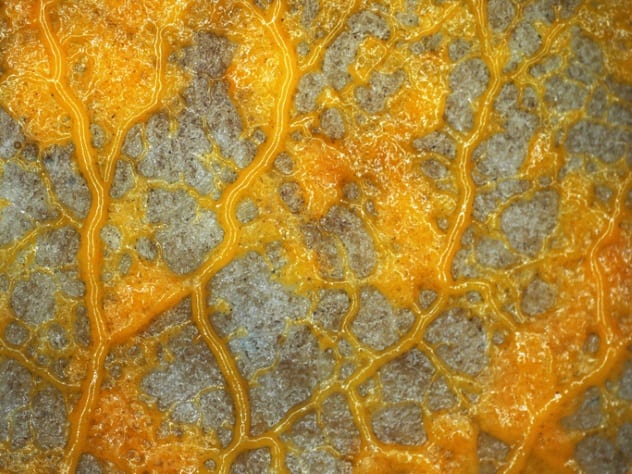
Slime molds are single-celled, eukaryotic organisms (think amoebae) that can grow up to 4 meters (13 ft) and exist all over the world, especially upon forest floors rich in rotting vegetation. They have no brain nor nervous system, yet they seem to make intelligent decisions when in search of food sources, often oozing, creeping, and flawlessly navigating through laboratory mazes at the speed of 1 centimeter (0.4 in) per hour. And with any luck, the reward will be its favorite dinner of porridge oats, which it will encase, dissolve, and absorb, in that order.[2]
These mindlessly simple life-forms resemble fungi and manifest into interesting shapes (one of which is dog vomit), and they spend their lives in the wild boldly oozing forth and merging with other slime mold cells, all the while branching out pseudopods in search of bacteria, yeast, and actual fungus for nourishment. They bring to mind, both in appearance and motivation, the cinematic “Blob” from the eponymous 1958 movie, though in miniature.
Because they are easy to keep and grow, slime molds have become a favorite research project for young scientists. But should any lab specimen ever grow larger than 4 meters and start creeping toward the lab assistant, the correct course of study would be toward the nearest exit!
8 Zombie Fungus
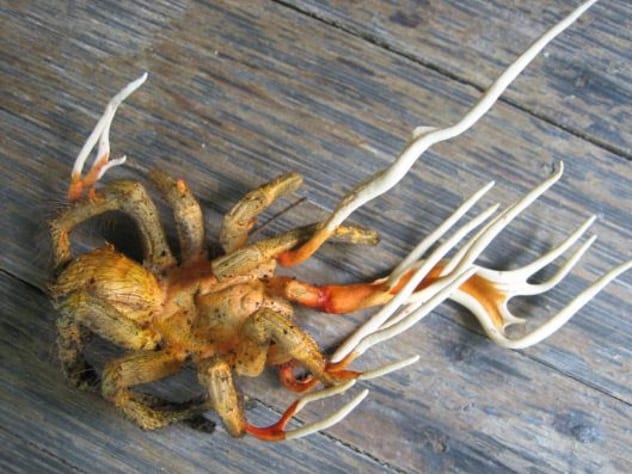
One of the most horrible creepy-crawlies in the world is the revolting tarantula; of that many can agree. Now, imagine it had an archenemy so much more sinister and repulsive that we were actually rooting for the well-being of the spider! It’s called Cordyceps, and it’s a fungus found mainly in tropical areas around the world, predominantly in Asia. It has the hideously unique capacity to invade the bodies of insects and spiders, replacing the host’s tissue with its own and completely transforming it in both flesh and behavior.
When Cordyceps infects a tarantula, the fungus systematically replaces the host’s tissue with its own, until it eventually kills it. At that point, long stalks and branching antlers sprout from all about the tarantula’s lifeless body, spreading spores to target other unsuspecting spiders.[3] In the process, these corpses become so ugly and alien that they look to be from some dark and evil arachnoid universe! Our hats are off for Cordyceps, however—it’s no small feat to over-excessively uglify a tarantula, dead or otherwise.
And as if that wasn’t bad enough, certain species of Cordyceps have been known to infest the tiny brains of ants and caterpillars, controlling their behavior to transport and spread more spores. It’s like a zombie apocalypse—arthropod style!
7 Invasion Of The Brown Snot Algae
Hypothetically, if a slime mold and a zombie fungus ever were to run off and elope, one of their likely offspring (at least in spirit) might possibly be the brown snot algae, which is proliferating profusely and clogging rivers and other waterways around the world. The assailant has been nicknamed “Didymo” (Didymosphenia geminata), and scientists are uncertain whether or not the diatom is spreading unchecked or was already indigenous worldwide to begin with. It seems to have started in British Columbia in the late 1980s, when thick mats of brown slime began contaminating several kilometers of river. And from there, it spread southward, onward, and so forth.[4]
This stuff is ugly—Swamp Thing-caliber ugly! Sometimes referred to equally unendearingly as “rock snot,” this gunk is becoming a worldwide problem for fishermen and the fish populations themselves. In New Zealand, it has infested dozens of waterways with a slimy thickness of up to 18 centimeters (7 in)! It has also been able to infest and contaminate freshwater aquariums.
Didymo is one of the most invasive species we have encountered to this day, and how doubly disheartening is the fact that it resembles wet toilet paper? Why can’t more invasive species in this world look and smell like roses?
6 Fisher Cats Need Not Apply
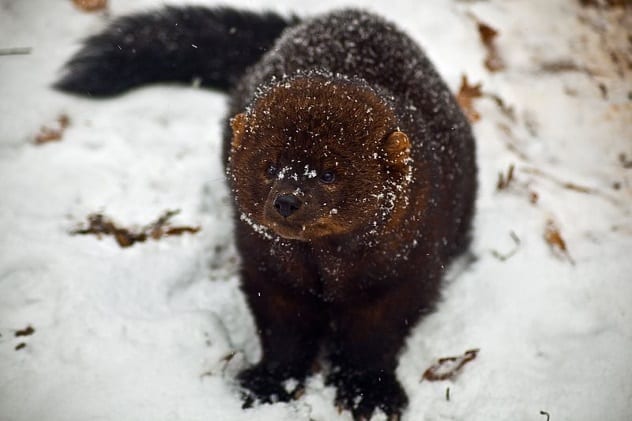
And finally on to an actual critter, not that you’d want this particular one in your backyard . . .
Fisher cats, often simply called fishers, are the second-largest member of the weasel family, averaging 81 to 102 centimeters (32–40 in) in length. They are neither proper cats, nor do they catch fish (unless they stumble across one while raiding your trash can); they are, however, excellent and efficient killing machines with long, sharp claws and teeth, and they are also the bane of suburban and woodland residents throughout Canada and the Northern US. These things are hideous and bloodthirsty, sometimes killing just for the joy of it, and they climb trees much like the squirrels they frequently chase, often screeching like banshees from the upper limbs. Tarzan would probably run from one of these things. They attack and eat just about any type of rodent, mammal, or bird they can manage to overtake, and as the ‘burbs encroach upon their territory (or vice versa in the opinion of many people), this conniving critter is rapidly losing fear of humans and our pets!
During the 1700s and into the 1800s, fisher cats were eradicated from the Northeast US by unregulated fur trapping and the expansion of farmland into the wilderness. But in the 1950s, fishers were reintroduced to Northern New England to control the overpopulation of porcupines, which fishers easily catch and then carefully eat. But the porcupines are not the only ones unhappy about the fisher’s reinstatement. The forests might since have retaken and replenished the old colonial farmlands in the north, but their surroundings are very different these days, and fisher cats often rampage out of the woods and into residential areas. So watch out Garfield! While raccoons might have always held a bad reputation for raiding the trash, they don’t also slay your poodle and eat your cat during the visit. Fishers are notorious for this type of behavior, and they’ve been known to attack children as well. And if you have a henhouse, you’d better fisher-proof it before one breaks in and needlessly slaughters each and every chicken. Back in 2007, a solitary fisher raided a turkey farm in Connecticut and killed 68 birds before the owners ran it off! Fishers now inhabit areas they were never indigenous to, and the locals therein wonder about the wisdom of introducing such “killing machines,” especially since they have no natural enemies and seem to get bigger and badder each year.[5]
But fisher cats might have a natural enemy on the West Coast, and an effective one at that. Fishers have been relegated onto public land in Washington, Oregon, and California, though recently, illegal marijuana farming using rodenticides has been killing these carnivorous creatures, either directly or indirectly when they feed upon poisoned smaller animals. This is certainly unfortunate for the conservationists trying to repopulate these critters, though it’s truly hard to feel sorry for any animal that can take a bite out of a porcupine . . .
5 Have You Taken A Good Look At Crabs Lately?
We all like crab cakes, crab dip, and crab bisque, and we think amiably of these roly-poly, little sea creatures with their cute, wobbly eyestalks and crazy sideways walk. Perhaps we ponder upon that colorful Disney crab Sebastian and smile. But if you knew what some crabs actually look like, you’d either lose your appetite for seafood or just spring for lobster!
Have you seen the Japanese spider crab (Macrocheira kaempferi ), which is believed to live up to 100 years and has long, reedy legs spanning up to four meters (13 ft)? How would you like to have those crab legs brought to your table, hmm? And have you heard of that recently discovered species of tree crab in India (Kani maranjandu), which resemble black spiders in size, shape, agility, and speed? Would you want those in your bisque? And how about that 15-meter (50 ft) Crabzilla lurking in Whitstable Harbour in the UK? Well, turns out that photo was just a hoax, but believe it or not, there is one other type of crab just as scary . . .
. . . or scarier! We’re talking meter-long (3.3 ft) coconut crabs—those tree-climbing, island-dwelling monstrosities that not only crack open and eat coconuts but also hunt rats and birds.[6] Some even belive that these giant nutcrackers might have eaten Amelia Earhart! Unbelievably, people have been known to keep coconut crabs as pets, and some have even allegedly kept them as slaves; island villagers have reportedly used them to guard their coconut plantations, as they become irascible toward intruders. Imagine being a coconut crop burglar by moonlight only to encounter a horde of ticked-off, scurrying coconut crabs, each of which could easily reach out and pinch you above the knee. That should make any common thief change his ways—and real quick!
4 Tree Tumbo, That Ancient Eyesore
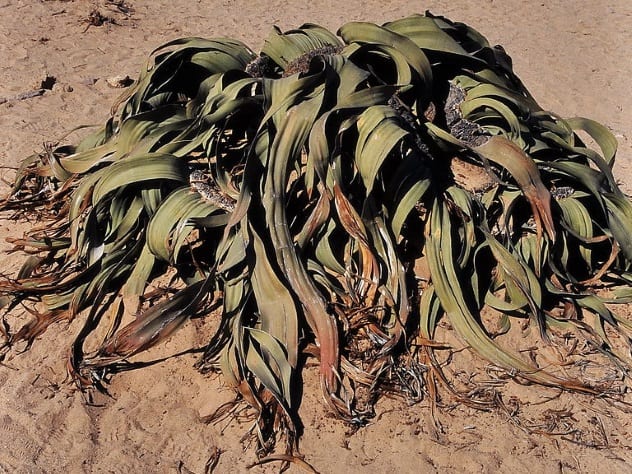
Most visitors to the Namib Desert in coastal Southwest Africa often pass by the tree tumbo (Welwitschia mirabilis) without thinking it to be a tree. Others pass by without even acknowledging it as a life-form. And no wonder: this low-lying veggie heap looks like a cross between something the cat dragged in and the garbage disposal belched out. And even though the tree tumbo appears to be refuse that should have been hauled, let us examine this ancient plant a bit more closely (but not too close).
The tree tumbo (also called “tumboa,” “onion of the desert,” and “What the heck is that?”) is a living fossil that dates all the way back to the Jurassic Period. This is basically a tree that is driven underground, with a subterranean trunk that taps water from the soil in an arid environment. Tree tumbo pretty much stands alone taxonomically, as it is a relic from the past; as the Jurassic environment changed, becoming more inhospitable and dry, its relatives became extinct. Despite all that, some of these individual plants are suspected to be up to 2,000 years old! Yes, tumboa proudly remains with us today due to its structure and adaptability, even though it is contained within a narrow strip about 1000 kilometers (600 mi) in length along the coast between Central Namibia and Southern Angola.[7]
We respect your longevity, tree tumbo, and we admire your resourcefulness, but let’s talk makeover.
3 The Strangler Fig
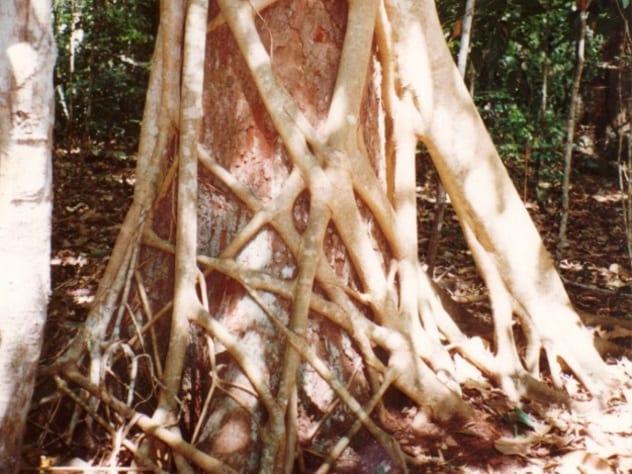
Imagine that you’re just standing around, minding your own business, living the life, when suddenly, the strong and unbreakable grasp of a stranger entangles you . . . and the miscreant’s long and slithery limbs continue to encompass your entire body up until the point you realize you are being entirely suppressed and slowly strangled.
This is happening to innocent trees in rain forests across the world every day! The strangler fig tree has adapted itself uniquely as an example of an external parasite upon other trees. The strangler fig starts off life as an epiphyte (a plant that nestles itself upon another) due to birds transporting seeds as they defecate onto branches and into crooks of host trees. As the epiphyte grows, it wraps its roots up, down, and all around its host, to the point where it eventually engulfs and overwhelms it with continuously snaking branches. At this point, the two trees compete for nutrients, and often, the strangler fig dies. But much more horrifying is when it doesn’t die.
If the host tree loses this wooden arm wrestling match, it eventually dies and rots away, leaving the strangler fig a creepy shell of winding roots and branches engulfing the nothingness of thin air![8] When this happens, we’re left with the surreal touch of unreality, much like a ship in a bottle, or perhaps some miraculous staircase winding up into the heavens. But the myriad of small birds and mammals that hang their hats within this spiraling enigma just call it home, and the rent couldn’t be better.
2 Jackal Food
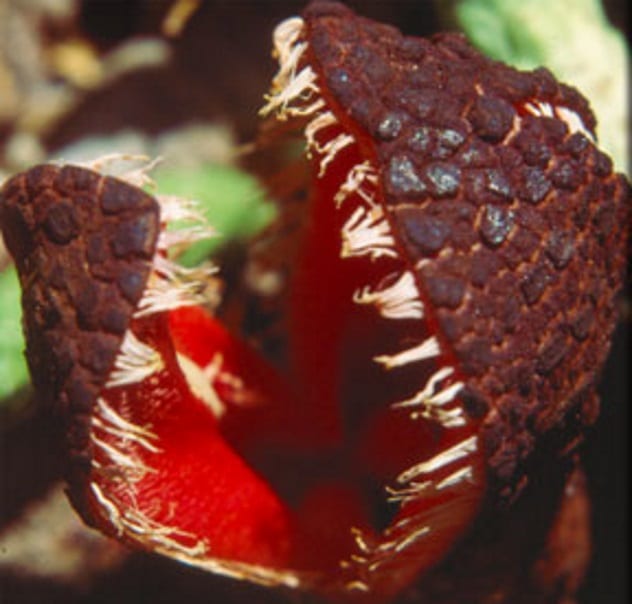
In the dry, coastal thickets of Southern Africa, there is a plant so ugly and repulsive that the kindest words of endearment the locals can call this thing are “jackal food” (Hydnora africana). It lives its life mostly underground as a parasitic network of stems and roots subsisting off succulent plants of the genus Euphorbia, and it rears its ugly head (technically a flower, believe it or not) when it comes time to pollinate and reproduce. This plant has scales instead of leaves, it lacks chlorophyll, and its “head” has a very odd resemblance to Pac-Man on crack. These flowers stink unpleasantly like dung, a trait which attracts small beetles to their “mouths,” as if their appearance wasn’t bad enough. This parasitic atrocity is so horrible that it makes a Venus flytrap seem like a bouquet of baby’s breath in comparison!
Ironically, this plant has a couple of favorable qualities, the first of which is that it eventually releases the beetles it catches in its maw. Seems it doesn’t help pollination any to eat the beetles who are doing the pollinating.[9] Also, despite the scaliness of its “head,” it has astringent properties which can be used to treat acne. Go figure.
1 Invasion Of The . . . Ladybugs?
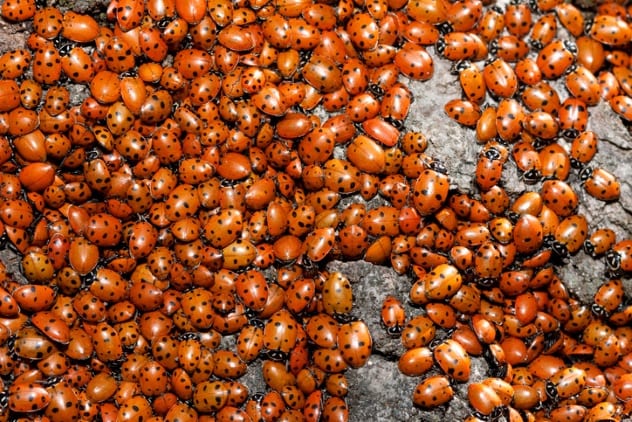
Ladybugs, or ladybirds as they are known in the UK, are probably the cutesiest of all insects. Even the faintest of heart delight in their fluttery arrival, and many people consider them to be good luck.
Now imagine thousands of them bringing good luck right to your front door—as well as your back door, your patio, and your rooftop. And, as if eager to bestow even more good tidings, they come into your house through any opening they can possibly find! This happens to homes in the Eastern US throughout October into November as these little, unwanted houseguests seek a warm place to hole up for the winter. They seem to pick out individual houses, often completely ignoring neighboring structures, and the crawling, writhing swarm of little red insects can be very distressing to the occupants within. People have had to remove them from their homes with shovels!
Fortunately, experts are able to give us a couple tidbits of advice. A swarm of ladybugs are more likely to choose light-colored houses with natural wood siding and lots of fissures—so hurry, there’s still time to remodel. Secondly, watch where you step. Squashing a bunch of them underfoot has been known to stain the carpet.[10]
Read about more decidedly creepy life-forms on 10 Sea Creatures That Belong On Another Planet and 10 Otherworldly Subterranean Creatures.








